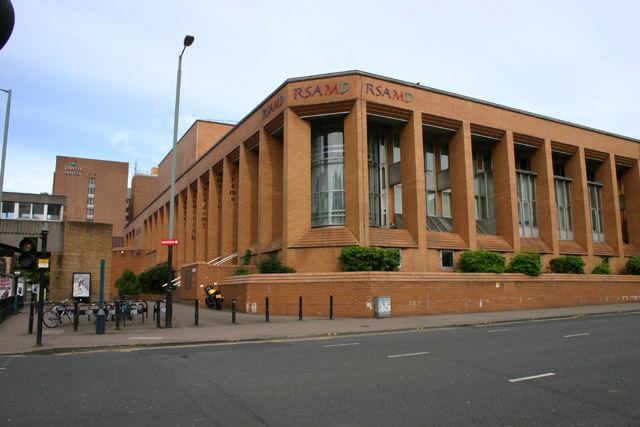Type Conservatoire Principal Jeffrey Sharkey Phone +44 141 332 4101 Founded 1845 Postgraduates 160 (2013–2014) | President Sir Cameron Mackintosh Number of students 985 (2014–2015) Undergraduates 765 (2013–2014) | |
 | ||
Affiliations Conservatoires UK, Associated Board of the Royal Schools of Music, University of St Andrews, Association of European Conservatoires, Conference of Drama Schools Address 100 Renfrew St, Glasgow G2 3DB, UK Notable alumni Similar Royal Northern College o, Royal Academy of Music, Royal College of Music, Royal Welsh College o, Queen Margaret University Profiles | ||
Studying at the royal conservatoire of scotland
The Royal Conservatoire of Scotland, (Scottish Gaelic: Conservatoire Rìoghail na h-Alba) formerly the Royal Scottish Academy of Music and Drama, is a conservatoire of dance, drama, music, production and screen in the centre of Glasgow, Scotland. Founded in 1845 as the Glasgow Educational Association, it is the busiest performing arts venue in Scotland with over 500 public performances each year.
Contents
- Studying at the royal conservatoire of scotland
- History
- Name change
- Facilities
- School of Music
- School of Drama Dance Production and Screen
- Junior Conservatoire
- References
The current Principal is American pianist and composer Jeffrey Sharkey, the President is Sir Cameron Mackintosh, and the Patron is HRH The Duke of Rothesay.
History
The Royal Conservatoire has occupied its current purpose-built building on Renfrew Street in Glasgow since 1988. Its roots lie in several different organisations. It began with the establishment of the Glasgow Educational Association in 1845, which formed to provide courses in competition with the University of Glasgow. The Association later became the Glasgow Commercial College, and this in turn became part of the Glasgow Athenaeum in 1847. The Glasgow Athenaeum provided training in commercial skills, literature, languages, sciences, mathematics and music. Charles Dickens gave its inaugural speech, in which he stated that he regarded the Glasgow Athenaeum as "...an educational example and encouragement to the rest of Scotland".
In 1888, the commercial teaching of the Glasgow Athenaeum separated to form the Athenaeum Commercial College, which, after several rebrandings and a merger, became the University of Strathclyde in 1964. In 1890 the non-commercial teaching side of the Glasgow Athenaeum became the Glasgow Athenaeum School of Music. In 1928 the premises were extended with a gift from the philanthropist Daniel Macaulay Stevenson. In 1929 the school was renamed as the Scottish National Academy of Music to better reflect its scope and purpose. Its first Principal from 1929–1941 was William Gillies Whittaker. In 1944, it became the Royal Scottish Academy of Music.
The Royal Scottish Academy of Music established a drama department called the Glasgow College of Dramatic Art during 1950. It became the first British drama school to contain a full, broadcast-specification television studio in 1962. In 1968 the Royal Scottish Academy of Music changed its name to the Royal Scottish Academy of Music and Drama (RSAMD) and introduced its first degree courses, which were validated by the University of Glasgow.
In 1993 RSAMD became the first conservatoire in the United Kingdom to be granted its own degree-awarding powers. Research degrees undertaken at RSAMD are validated and awarded by the University of St Andrews in Fife. RSAMD is one of four member conservatories of the Associated Board of the Royal Schools of Music.
Name change
From 1 September 2011, the RSAMD changed its name to the Royal Conservatoire of Scotland. They decided on the name change after a long consultation process that involved the principal and the Academy's board of directors, as well as past and present students and staff, arts & academic institutions, politicians, and the Royal Protocol Unit.
Principal John Wallace said the new name was necessary to cover all fields that the institute offers, as it no longer is simply a music and drama academy. Undergraduate courses in areas such as Digital Film & Television, Production Arts and Design, Production Technology and Management, Musical Theatre and Modern Ballet (in partnership with Scottish Ballet) have been added to the degrees the Royal Conservatoire offers. The Principal felt it was best to choose a name that was representative of all disciplines offered.
Facilities
The Royal Conservatoire has a range of facilities, including several performance spaces: the Ledger Room, Stevenson Hall, the Chandler Studio Theatre, the New Athenaeum Theatre, and the Alexander Gibson Opera Studio (built in 1998). There are around 65 private practice rooms for music students, each equipped with a piano with stool, music stand and chairs. These include 11 rooms reserved solely for pianists, several rooms for use by the Scottish Music department, and 8 rehearsal and coaching rooms. The Royal Conservatoire also houses several professional recording studios, including a new studio in the Opera School for the use of large ensembles.
The Royal Conservatoire also has an automated flying system in its main performing venue, the New Athenaeum Theatre, meaning it has become the first educational establishment in the UK to offer Stage Automation Training as part of the curriculum.
In 2010, RCS opened its second campus near Cowcaddens, now known as the "Wallace Studios at Speirs Locks". This building was designed by Malcolm Fraser. It opened predominantly to house the Modern Ballet and Production courses, as the Renfrew Street campus was struggling to accommodate the combination of new courses and higher intake levels. In 2014, a £2 million extension to this second campus was built, creating even more rehearsal spaces and improved facilities for the students.
The Royal Conservatoire's extensive archive of historical papers and ephemera charts both its own institutional history and the wider performance history of Scotland.
